Lorica segmentata
The lorica segmentata (Latin pronunciation: [ɫoːˈriːka s̠ɛɡmɛn̪ˈt̪aːt̪a]), also called lorica lamminata ([ɫamːɪˈnaːt̪a]; see §Name), is a type of personal armour that was used by soldiers of the Roman Empire, consisting of metal strips fashioned into circular bands, fastened to internal leather straps. The lorica segmentata has come to be viewed as iconic of the Roman legions in popular culture. The tendency to portray Roman legionaries clad in this type of armour often extends to periods of time that are too early or too late in history.
 |
| Part of a series on the |
| Military of ancient Rome |
|---|
|
|
History
Despite the armor being commonly associated with the Romans, the armor was used by other civilizations before the Romans.[1] The armor was used by the Parthians and possible the Dacians, Scythians, or Sarmatians before the Romans used it. Some sets of armor similar to the lorica segmentata dating back to the 4th century BC have been found in archaeological sites located in the steppe. The Dendra Curiass is a set of armor similar to the lorica segmentata that has been dated back to the 15th century BC.[1] The armor was first used in the early 1st century.[1] Although, the exact time in which the Romans adopted the armor remains unknown. Some say it was after Crassus' defeat at Carrhae in 53 BC.[1]Others say the armor was adopted in 21 AD after the Revolt of Julius Sacrovir and Julius Florus.[1] One form of the armor was used as early as 9 BC.[1] Because the soldiers at the Battle of Teutoberg Forest wore the lorica segmentata, we can conclude the armor must have been in use before 21 AD.[1] Around the middle of the third century the lorica segmentata fell out of favor with the Roman army. Although, it did remain in use during the Late Roman Empire.[1] The armor was still around in the 4th century. Soldiers wearing the lorica segmentata were depicted on the Arch of Constantine, a monument erected in 315. However, it has been argued that these depictions are from an earlier monument by Marcus Aurelius, from which Constantine incorporated portions into his Arch.[1] The latest known use of the armor was in the 4th century.[1]
Over time the type of lorica segmentata would change. From 9 BC to 43 AD the Roman soldier wore the Dngestetten-Kalkriese-Vindonissa type, from 69 to 100 the Corbridge-Carnuntum was used and from 164 to 180 Newstead type was used.[2] The time the armors were worn would overlap. It is possible that there was a fourth type, covering the body with segmented armour joined to scale shoulder defences. However, this is only known from one badly-damaged statue originating at Alba Iulia in Romania. The currently accepted range for the use of the armour is from about 14 B.C. to the late 3rd century A.D.[3] The lorica segmentata's use in the Roman army was geographically widespread, but the mail armor lorica hamata may have been more common at all times.
Usage in the Roman Army
The question as to precisely who used the armour is debated. On the monument, Auxilia are generally shown wearing mail, cuirasses, and carrying oval shields. Legionaries are uniformly depicted wearing the lorica segmentata and carrying the curved rectangular shield.[4] On this basis, it has been supposed that lorica segmentata was exclusively used by legionaries and praetorians.[1] However, some historians consider Trajan's Column to be inaccurate as a historical source due to its inaccurate and stylised portrayal of Roman armour. These historians also say that "it is probably safest to interpret the Column reliefs as ‘impressions’, rather than accurate representations." [1] The discovery of parts of the lorica segmentata at areas where auxiliary soldiers would have been stationed implies that auxiliary troops used the lorica segmentata. However, it is entirely possible that the reason behind the presence of the lorica segmentata in these areas could because these areas had a small amount of legionaries stationed there.[1] On the Adamclisi Tropaeum the lorica segmentata does not appear at all, and legionaries and auxilia alike are depicted wearing the lorica squamata. Some experts are of the opinion that the Adamclisi monument is a more accurate portrayal of the situation,[5] the segmentata used rarely, maybe only for set-piece battles and parades. This viewpoint considers the figures in Trajan's Column to be highly stereotyped, in order to distinguish clearly between different types of troops.[6]
Forging
The plates in the lorica segmentata armour were made by overlapping ferrous plates that were than riveted to straps made from leather.[1][7][8]It is unknown what animal was used to make the leather and if the leather was tanned or tawed.[1] The plates were soft iron on the inside and rolled mild steel on the outside,[1] making the plates hardened against damage without becoming brittle.[9] This case hardening was done by packing organic matter tightly around them and heating them in a forge, transferring carbon from the burnt materials into the surface of the metal.[10] The plates were made from beating out ingots.[1] The strips were arranged horizontally on the body, overlapping downwards, and they surrounded the torso in two halves, being fastened at the front and back. The upper body and shoulders were protected by additional strips ("shoulder guards") and breast- and backplates. The form of the armour allowed it to be stored very compactly, since it was possible to separate it into four sections, each of which would collapse on itself into a compact mass. The fitments that closed the various plate sections together (buckles, lobate hinges, hinged straps, tie-hooks, tie-rings, etc.) were made of brass. In later variants dating from around 75–80 A.D., the fastenings of the armour were simplified. Bronze hinges were removed in favour of simple rivets, belt fastenings utilized small hooks, and the lowest two girdle plates were replaced by one broad plate. The component parts of the lorica segemtata moved in synchronization with the other parts.[1] This made it so the armor was more flexible.[1][11]The armor was very long lasting. The Kalkriese type of armor lasted 55 years. the Corbridge armor lasted 70 years, and the Newsteadtype lasted 90 years.[1]Despite the longevity of the armor, all evidence points to the armor being very fragile.[1]
Name
In Latin, the name lorica segmentata translates to "segmented cuirass." However, this name was not given to the armor by the Romans. Instead, it was given by scholars in the 16th century.[1] Despite the lack of knowledge on the Roman name for the armor, scholars can make educated guesses on the Roman name. It is obvious the name had the word lorica in its name.[1] However, the following part of the name is unknown.[1] Some scholars believe that the name was lorica lamminata.[1] This theory is based of the fact that the Romans referred to sheets of metal as lamina.[1] Although, there is no firm evidence for any theory regarding the name of the armor.[1]
.jpg.webp) Relief from Trajan's Column showing a legionary with lorica segmentata, manning a carroballista
Relief from Trajan's Column showing a legionary with lorica segmentata, manning a carroballista.jpg.webp) Detail of Trajan's Column
Detail of Trajan's Column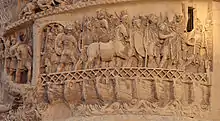 Roman legionaries crossing the Danube River by pontoon bridge, as depicted in relief on the column of Emperor Marcus Aurelius (r. 161-180 AD) in Rome, Italy
Roman legionaries crossing the Danube River by pontoon bridge, as depicted in relief on the column of Emperor Marcus Aurelius (r. 161-180 AD) in Rome, Italy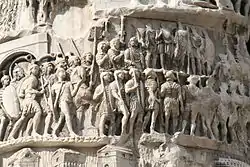 Column of Marcus Aurelius, Rome, Italy
Column of Marcus Aurelius, Rome, Italy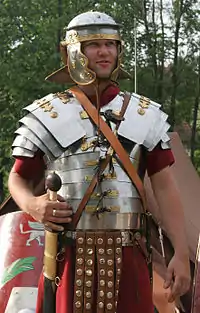 A reenactor dressed as a Roman soldier in lorica segmentata
A reenactor dressed as a Roman soldier in lorica segmentata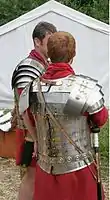
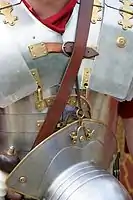
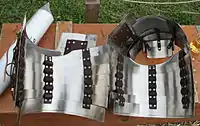
See also
- Laminar armour
- Manica – Roman armguard of similar construction
- Lorica plumata
- Lorica Hamata
- Lorica Squamata
References
- Bishop, M.C (2002). Lorica Segmentata Volume I: A Handbook of Articulated Roman Plate Armour. Great Britain: THE ARMATVRA PRESS. ISBN 0-953-9848-42.
- D'Amato & Sumner 2009, p. 131.
- D'Amato & Sumner 2009, p. 130.
- L. Rossi Trajan's Column and the Dacian Wars (Thames & Hudson 1971) 102
- Mattingly op cit 207
- Rossi op cit 59
- Bishop, M.C. "The Newstead lorica segmentata". Journal of Roman Military Equipment Studies. Volume 10.
- Bishop, M.C (1988). Excavations at Roman Cordbridge. English Heritage.
- David Sim (at Reading University)
- "Iron for the Eagles", by David Sim & Isabel Ridge
- Webster, Graham (1985). The Roman Imperial Army of the First and Second Century A.D. University of Oklahoma Press. ISBN 0-8061-3000-8.
Bibliography
External links
| Wikimedia Commons has media related to Lorica segmentata. |
- Lorica Segmentata Volume I: A Handbook of Articulated Roman Plate Armour, M.C. Bishop, Armatura Press (November 1, 2002) (online version)
- Roman Army website, showing the third century finds of segmentata in spain (downloadable PDF)
- Ancient originals on the pages of the Roman Military Equipment Web Museum
.jpg.webp)
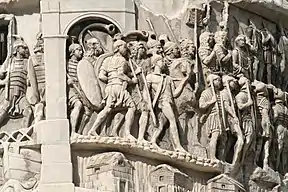
.jpg.webp)
